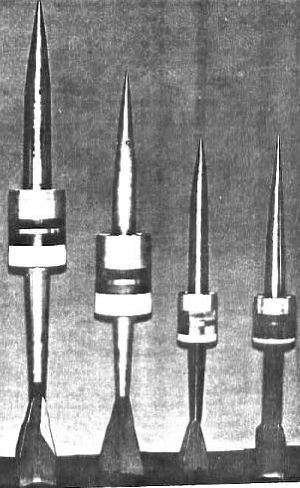
Home - Search - Browse - Alphabetic Index: 0- 1- 2- 3- 4- 5- 6- 7- 8- 9
A- B- C- D- E- F- G- H- I- J- K- L- M- N- O- P- Q- R- S- T- U- V- W- X- Y- Z
5 inch HARP Gun
 HARP 7 & 5 in probes From left to right: HARP 7-1, 7-2, 5-1, and 5-3. |
AKA: Gun05;High Altitude Research Project. Status: Active. First Launch: 1965-02-02. Last Launch: 2008-04-10. Number: 124 . Payload: 10 kg (22 lb). Height: 1.16 m (3.80 ft). Diameter: 0.13 m (0.42 ft). Apogee: 76 km (47 mi).
The development of the small guns began well before the beginning of the HARP Project. Some of the first experiments were conducted by Dr. Gerald Bull at the Canadian Armament and Research Development Establishment (CARDE) in the mid-fifties using guns as small as small as 76 mm. By the late fifties Dr. Bull's work had attracted the attention of the US Army's Ballistic Research Laboratory (BRL) and informal talks indicated there was considerable enthusiasm in the joint development of a gun-launched sounding probe. During late 1960 and early 1961 both CARDE and BRL conducted feasibility studies which indicated that reasonable payloads could be flown to considerable altitudes by gun-launched sub-caliber probes.
In early March 1960 these studies came to the attention of The US Army's Chief of Army Research and Development, Lt. Gen. Arthur Trudeau. At the time there was an almost desperate need for a low cost launch system which could cover the altitudes above those of aircraft or balloons to conduct extensive atmospheric research in support of the development of new supersonic aircraft and of missile systems. Lt. Gen. Trudeau realized that a low-cost gun-launched probe could quite likely solve this need. By July of 1960 BRL had proven the structural integrity of a small gun-launched probe in horizontal tests, but the project had to be scaled back as no funds were available for vertical test firings. By the end of 1960 the work at CARDE had been terminated primarily due to the difficulties encountered in setting up a joint, non-military program between BRL and CARDE. In early 1961 funds became available for BRL to conduct a few vertical test firings which proved the feasibility of this type of launch system. The lessons learned during these first tests led to a second generation of launch probes which were adopted by HARP a few years later.
The 5 inch L70 gun launchers used by HARP were provided by BRL and were based on a modified 120 mm T123 service gun. The major modifications to these guns were to smooth-bore the barrel, and to weld a second barrel section to the first. This lengthened the barrel to 8.9 m (29 feet). To maintain barrel alignment, three sets of stiffening wires were added, permitting an adjustable alignment relative to the firing angle. The standard gun carriage was mounted on a 45 degree platform to allow the barrel to be elevate to vertical for high altitude launches. The probes were rammed into the bore with a hydraulic jack to insure a consistent start pressure. A 16 kg (35 lb) charge of M17 propellant was loaded in a conventional brass shell case. The relatively small size and simplicity of these 5 inch gun launchers allowed them to retain their high mobility and they were easily transportable by truck, by train or by ship.
The portability of the of the 5 inch gun system allowed the HARP project to set up six launch sites across North America and in the Caribbean. These sites included Barbados; Highwater, Quebec; Ft Greely, Alaska; Wallops Island, Virginia; White Sands, New Mexico; and Yuma Proving Ground, Arizona. These sites provided a broad base of atmospheric conditions to study. The firings produced a wealth of atmospheric information which is still in use today.
The 5 inch HARP gun probes were a remarkable successful instruments and some 300 flights were conducted over a 5 year period during HARP. With the main propulsion stage (the gun launcher) being a reusable ground based system the launch costs were in the range of about $300-$500 each flight providing a remarkably low cost launch system, which was more then capable of fulfilling its HARP role. Details of the HARP 5 inch payloads are at HARP 5-1 and HARP 5-3.
by Richard K Graf
Payload: 10 kg (22 lb) to a 76 km altitude. Launch Price $: 0.000 million in 1962 dollars.
Family: Gun-launched. Country: Canada. Spacecraft: HARP 5-1, HARP 5-3. Agency: Bull.
Back to top of page
Home - Search - Browse - Alphabetic Index: 0- 1- 2- 3- 4- 5- 6- 7- 8- 9
A- B- C- D- E- F- G- H- I- J- K- L- M- N- O- P- Q- R- S- T- U- V- W- X- Y- Z
© 1997-2019 Mark Wade - Contact
© / Conditions for Use